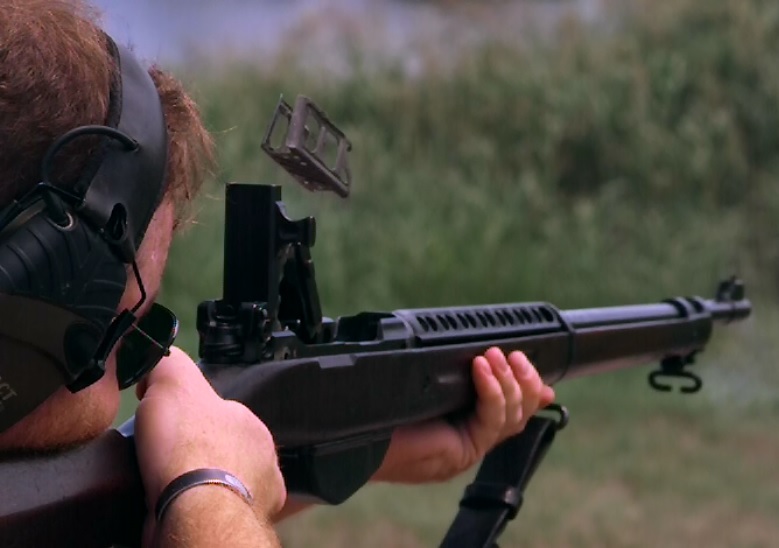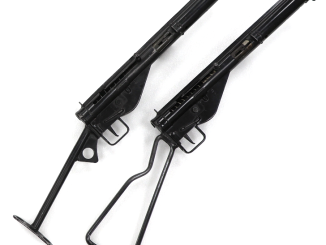The largest muzzleloading black powder cannons ever built were the Armstrong 100-ton guns which saw service with the Italian Navy and with British coastal fortifications on Malta and Gibraltar. They were purchased by the Italians first, to outfit a pair of new super battleships, each vessel having two turrets with two of these guns in each. To avoid being outclassed, the British ordered two guns for installation to protect the Grand Harbor of Malta and two more to protect Gibraltar. Today one survives at each location, and we are visiting the Rinella Battery in Malta, which was built to house one of the Maltese guns.
These guns had a maximum range of 8 miles, and was capable of piercing 15 inches of iron armor at 3 miles. It had a 17.7 inch (45cm) bore fired a 2000 pound (900 kg) shell with a 450 pound (200kg) charge of black powder. The gun itself weighed approximately 102 tons, and with its cradle and a shell the whole assembly came in at 150 tons.
Aside from the massive scale of the piece, the most interesting part of its design is actually the loading machinery. Because of the titanic size of the gun and ammunition, Armstrong designed a fascinating hydraulic reloading facility which makes up the body of the fortress in which the gun is set. A pair of steam engines drove a pair of hydraulic accumulators, which provided hydraulic pressure to move the gun on its carriage, to douse the barrel after firing, to hoist ammunition into position for loading and power a 60-foot (18m) ramrod to mechanically ram the charge and shell into place. Two mirror-image reloading galleries under the fortification operated in turn, giving the gun a sustained rate of fire of 1 round every 6 minutes – at least until its 120-round barrel life was exhausted.
I am grateful for the Malta Tourism Authority’s assistance in helping to make this visit and video possible, and would also like to give special thanks to Simon, our awesome reenactor guide!




“(…)Armstrong(…)Italian(…)British(…)”
Selling same weapon pattern for opposing side? This reminded me about:
His Systeme Zaharoff included the use of large bribes to government and military officials and his technique of playing one country off against its neighbour first came to the fore in 1885 when he sold one almost unusable submarine to Greece and then two of the same type to their longstanding rival Turkey in 1886.
from: https://firstworldwarhiddenhistory.wordpress.com/2015/07/22/munitions-8-the-munitions-8-the-strange-and-unendearing-story-of-basil-zaharoff/
However, at least Armstrong gun worked as intended.
Very VERY cool, Ian! And the old Naval photos I had never seen before with the Italian warships mounting “Monitor” gun turrets!
Very interesting, mega-steampunk, something right out of Jules Verne. But I don’t see how the gun was lowered to bring the muzzle in line with those loading ports. Clearly the bore axis of the gun is way higher than those ports. And although the mount ramps downward the gun appears to already be fully forward.
There is animation of loading that gun at wikipedia query:
https://en.wikipedia.org/wiki/100-ton_gun#Gallery
hope it will explain how it worked
The video doesn’t work for me. 🙁
“video doesn’t work for me.”
Hmm, although it has .ogv in name, if I am not mistaken, in reality it is .webm file and as such it is somewhat surprising it is not working in your browser. I can’t say much more as I do not know which browser you use, but please read page: https://www.webmproject.org/users/ and consider using any browser listed.
Try this one;
https://www.youtube.com/watch?v=eyItmfUO3WA
Thanks for that one Ian! Armstrong was a true genius. Selling arms as well as everything else made him a very rich man. His huge country estate is called Cragside in Northumberland and is open to the public. It was known as “the palace of a modern magician” and the sheer variety of his achievements is breathtaking. I was lucky enough to live on the estate for some years and it’s a magical place. Bit chilly in the winter though!
According to https://en.wikipedia.org/wiki/Clarke%27s_three_laws
Any sufficiently advanced technology is indistinguishable from magic.
I now appreciate the facility with which breech-loading guns are supported. The mammoth scale, monetary cost, and upkeep of loading tools for this artillery far outweighs any potential benefits apart from scaring would-be pirates into submission… then again, modern pirates aren’t the smartest guys on the seas. Sliding block artillery or screw-breech artillery seems to be the better deal. As for strange coastal defenses, try the steam-pulley-cable-driven torpedo. It’s considered the first effective actively guided munition ever built.
“Sliding block artillery or screw-breech artillery”
It was known that rifled ordnance provided more accuracy, a greater range and more penetrative power, which was the rationale behind the development and on-board shipping of the breech-loading cannon developed by the company owned by Sir William Armstrong. These weapons, however, were dangerously prone to failure, frequently explosively, and an alternative armament became urgently necessary(…)
from https://en.wikipedia.org/wiki/Muzzle-loading_rifle#British_Royal_Navy
Thus, reservations about breech-loaded weapons amongst Royal Navy ranks back then is understandable.
Been there on Holiday, and they have a nice collection of other artillery pieces too. Also, a whole bunch of still servicable Martini-Henry rifles, and a nice show including Lancers. Well worth a visit, but then again.. the whole of Malta is.
Let’s see. 120 round barrel life. 4 test shots per year. 20 years the barrel would be getting close to its last gasp. Heckuva weapon, however. But a good reminder how quickly the big dog becomes the old dog on the porch.
“old dog on the porch.”
Generally, coastal defense guns were often kept in service for long time, also Germans during WWII used great gamut of ancient and/or exotic guns to bolster effectiveness of Atlantikwall, see for example this table:
http://bunkersite.com/panzer/guns/guns-total.php
notice some yet of pre-WW1 vintage (for example 30,5 cm from Radetzky class)
A very good sectional drawing of the Elswick loading system for the 100 ton RML can be found on page 312, Vol XI of the ninth edition of the Encyclopedia Britannica. I know this because I have that very page framed and hanging on my wall! Found in a second-shop a while back. Not sure of its originality but it sure looks good. Well, to me it does.
There are other contemporary pictures of this colossal lump. One, showing a wheeled field piece with the wheels just straddling the barrel!
There is diagram in Wikipedia query:
https://en.wikipedia.org/wiki/File:RML_17.72_inch_gun_diagram.jpg
for ORDNANCE WROT IRON RIFLED MUZZLE-LOADING 17·72 INCH 100 TONS
I am not sure what WROT mean, but if I understand texts correctly, this weapon had progressive rifling (angle is not constant).
I think they meaned wrought-iron.. which would mean that mainly the outer bands are not cast, but hammered, re-heated, and forced over the breechpart were they cool down and shrink. This will reenforce the inner cast partsagainst the force of the explosion. by adding counterpressure in the direction of the core.
Very interesting – a good historical reference would be the largest gun built in the U.S. during the American Civil War: the 20 inch Rodman Columbiad. This ~ 100 ton cast iron smoothbore muzzleloader fired round (spherical) ammunition only, either shells or shot, using a 100 lb charge of mammoth grain black powder, throwing a 1000 lb shot I believe about 5 miles. If I remember correctly, the idea was that had the war continued, U.S. monitor type ships would be armed with these guns, which would have simply devastated any ironclad afloat in those days.
They were test fired late in the war, but, like these Armstrong guns, never fired in anger.
Another comparable weapon: https://en.wikipedia.org/wiki/Tsar_Cannon#Perm_Tsar_Cannon
Thank you Ian. Your Forgotten History videos are a fantastic addition. I will say that I had hopes of seeing a clip of that gun firing, the video thumbnail was a bit of a tease. Keep up the good work
There are several videos of that gun being fired. Just search up Armstrong 100 ton gun firing.
Regarding the Italian sales.
Iirc, Armstrong or the later Vickers Armstrong, had a works on the northern shore of the bay of Naples.
Armstrong was allowed setting up an industrial complex in Pozzuoli in 1885 as Stabilimenti Meccanici di Pozzuoli, while Vickers formed up a 60/40 joint venture with Terni Steel Mills as the dominant part in 1905, with the main production facility in La Spezia. It would later become OTO Melara.
Six minutes to reload; 20 minutes for the cloud of smoke from 450 lbs of black powder to clear. Sheesh.
Here is a near contemporary illustration showing the loading procedure for this monster. Those Victorian engineers liked to think big and weren’t troubled by the size of the task. Private Jones may have thought otherwise. All this in the day of the horse and cart!
https://www.alamy.com/gunnery-carriage-iron-wrought-garrison-moncrieff-gun-
“File not found”
The cost to fire one round was the equivalent of one day’s pay for 2,500 soldiers. Source, biography by Henrietta Heald
There is a lot of info on these guns including video of firing them. Just look it up.
The 100-ton cannon looks like something that the FF9 airships would use in battle against Garland’s legion of Silver Dragons.
In your youtube video on the gun you wonder why the Army did not scrap the one remai g gun. It was simple the gun was in the middle of Royal Navy range. The range was closed by my farther in 1959. As a schoolboy I used to play on the gun and its little castle
The military college I attended, Norwich University in Vermont, has a couple of breech loading Armstrongs in their collection that they have had since just before the American Civil War. I think they are 12 pounders like the pair of James muzzle loaders they also have.